Drywall is in and finished. Priming and point-up is almost done. Electricity has been connected to the house. It's very exciting to see the house lit up to get an idea of how it will feel to live in it.
 This is a wide angle view of the basement. From the left: Door going out the areaway, the short blue wall is actually a used solid wood door that will be finished to look like it is part of the wall. Through the door will be storage, hot water heater, one of the air handlers, and the sump-pump. Next to the door are the stairs, the black square is the air return, and two 200 amp electrical panels. If you look closely you can make out an extension cord plugged into the wall, not a temporary pole outside. Fantastic!
This is a wide angle view of the basement. From the left: Door going out the areaway, the short blue wall is actually a used solid wood door that will be finished to look like it is part of the wall. Through the door will be storage, hot water heater, one of the air handlers, and the sump-pump. Next to the door are the stairs, the black square is the air return, and two 200 amp electrical panels. If you look closely you can make out an extension cord plugged into the wall, not a temporary pole outside. Fantastic! These spotlights that are throughout the basement and first floors are meant for a track lighting system. We reworked them to work with the exposed conduit. The lights originally had paint on them and they have been painstakingly sanded down to expose their raw metal. Not only was it an exercise in obsessive behavior, but it better matches the electrical conduit.
These spotlights that are throughout the basement and first floors are meant for a track lighting system. We reworked them to work with the exposed conduit. The lights originally had paint on them and they have been painstakingly sanded down to expose their raw metal. Not only was it an exercise in obsessive behavior, but it better matches the electrical conduit. This is the view as you walk through the front door. The unfinished room to the left is the half bath.
This is the view as you walk through the front door. The unfinished room to the left is the half bath. 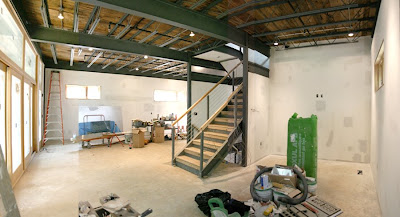


 Various views of the first floor.
Various views of the first floor. As you're walking up the stairs the AMS USA stamp on some of the steel beams can be seen. Details, details, details.
As you're walking up the stairs the AMS USA stamp on some of the steel beams can be seen. Details, details, details.  Views of one of the bedrooms on the second floor. All interior doors are fir to match the window jambs. Most of the doors are 8' tall to keep in scale with the ceiling height.
Views of one of the bedrooms on the second floor. All interior doors are fir to match the window jambs. Most of the doors are 8' tall to keep in scale with the ceiling height. Around the window and door jambs are half inch aluminum reveal trim. That is the finished look. No other casing is to be applied.
Around the window and door jambs are half inch aluminum reveal trim. That is the finished look. No other casing is to be applied. Views of the full bath.
Views of the full bath. View of the master bedroom.
View of the master bedroom.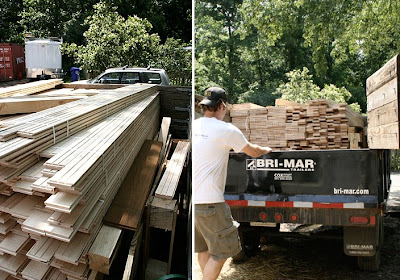 The FSC certified maple flooring has arrived. It will acclimate in the house for a couple week before it is installed to get the moisture content within a few percentage points of the subfloor. That will*hopefully* prevent cupping and gapping of the floor.
The FSC certified maple flooring has arrived. It will acclimate in the house for a couple week before it is installed to get the moisture content within a few percentage points of the subfloor. That will*hopefully* prevent cupping and gapping of the floor.
 The gutters have been added to the outside, along with the final roof trim. The series of stacked windows on the left side of the house will be frosted, as they all look into bathrooms. The frost will also give the windows a continuous, top-to-bottom, flowing look.
The gutters have been added to the outside, along with the final roof trim. The series of stacked windows on the left side of the house will be frosted, as they all look into bathrooms. The frost will also give the windows a continuous, top-to-bottom, flowing look. Here you can see the continuation of the roof trim, the addition of the handrails on the balcony, and the final color of the steel vertical beams (it's hard to see but they were painted green to match the windows).
Here you can see the continuation of the roof trim, the addition of the handrails on the balcony, and the final color of the steel vertical beams (it's hard to see but they were painted green to match the windows). Views of the upstairs balcony.
Views of the upstairs balcony.  The interior stairwell is nearly finished. Tension cable railings are carried through from the outside to the inside. Pine wood 2x4s have been
The interior stairwell is nearly finished. Tension cable railings are carried through from the outside to the inside. Pine wood 2x4s have been  Old growth "real" oak 2x4s that were salvaged from the old razed house are
Old growth "real" oak 2x4s that were salvaged from the old razed house are 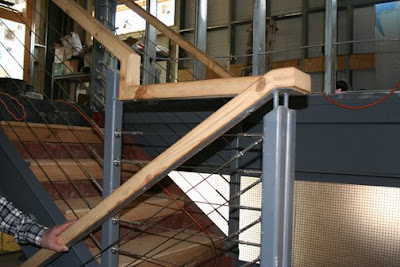
 The owner wanted to retain an open feeling between landings but close off direct view into the basement. An acrylic panel with mesh wiring inlaid is used to
The owner wanted to retain an open feeling between landings but close off direct view into the basement. An acrylic panel with mesh wiring inlaid is used to  Due to the building codes in Montgomery County all new houses must have a sprinkler system. Fortunately, this requirement fits in wonderfully with the open ceiling plan. We chose to keep the sprinkler pipes raw and we cleaned them up with vegetable oil to allow their original color to show through. The rawness of the color works well with the steel beams and electrical conduits will be left raw as well.
Due to the building codes in Montgomery County all new houses must have a sprinkler system. Fortunately, this requirement fits in wonderfully with the open ceiling plan. We chose to keep the sprinkler pipes raw and we cleaned them up with vegetable oil to allow their original color to show through. The rawness of the color works well with the steel beams and electrical conduits will be left raw as well. 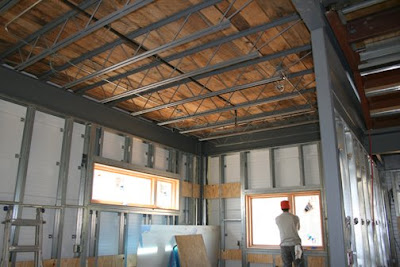 All the steel I-beams and joists are painted a neutral but warm grey that goes well with the warmth and aged look of the oak ceiling planks.
All the steel I-beams and joists are painted a neutral but warm grey that goes well with the warmth and aged look of the oak ceiling planks. 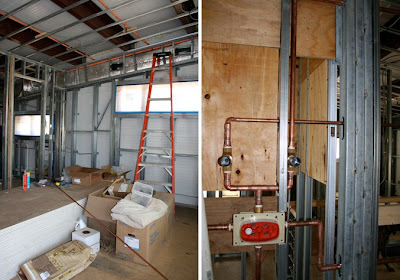 A view into the Master bedroom and bath.
A view into the Master bedroom and bath.  The home is going to be heated and cooled by two zone 16 seer heat pumps. They have variable speed fans so that they can cycle on and off with more efficiency. The home will be so well insulated that it is actually difficult finding HVAC units that are small enough. The picture above is the air handler unit for the upper floor tucked above the ceiling of the hall bath. Access will be through a hinged mirror in the master bath.
The home is going to be heated and cooled by two zone 16 seer heat pumps. They have variable speed fans so that they can cycle on and off with more efficiency. The home will be so well insulated that it is actually difficult finding HVAC units that are small enough. The picture above is the air handler unit for the upper floor tucked above the ceiling of the hall bath. Access will be through a hinged mirror in the master bath.
 Basement
Basement 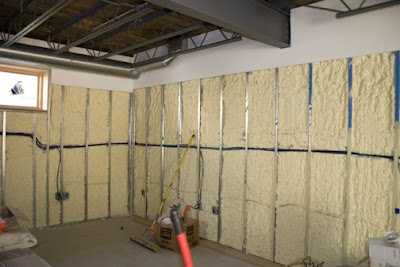 Although the basement is 5 feet underground and has 12" thick concrete walls, we sprayed 4" of foam insulation to insure the highest level of energy efficiency possible.
Although the basement is 5 feet underground and has 12" thick concrete walls, we sprayed 4" of foam insulation to insure the highest level of energy efficiency possible.